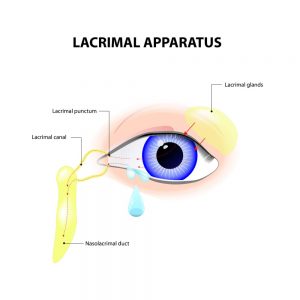Epiphora: A Symptom of Canalicular Stenosis
Epiphora, or excessive tearing, is an eye condition resulting from canalicular stenosis. While epiphora can have many causes, one notable cause is the drug Taxotere (docetaxel), a taxane-based chemotherapy drug. Studies have long shown a clear link between canalicular stenosis, epiphora, and docetaxel, particularly when the drug is administered weekly.
 Docetaxel causes canalicular stenosis by obstructing the lacrimal canaliculi, or the tiny channels that allow tears to drain from the eyes. This obstruction can lead to many eye problems, including epiphora. Because canalicular stenosis can cause severe, permanent damage, it is vital to catch and treat it immediately. Taxotere side effects such as epiphora can significantly disrupt your daily routines and reduce your quality of life.
Docetaxel causes canalicular stenosis by obstructing the lacrimal canaliculi, or the tiny channels that allow tears to drain from the eyes. This obstruction can lead to many eye problems, including epiphora. Because canalicular stenosis can cause severe, permanent damage, it is vital to catch and treat it immediately. Taxotere side effects such as epiphora can significantly disrupt your daily routines and reduce your quality of life.
To find out if you are eligible for a Taxotere watery eyes lawsuit, fill in our case evaluation quiz or call our office at (800) 763-6155.
Symptoms of Epiphora

Tears cannot drain from the eye when the canaliculi become narrow or blocked. Tears are then forced back into the eyes and, with nowhere else to go, end up streaming down the cheeks. Some of the most common symptoms of epiphora include:
- Constant painful tearing
- Red eyes and enlarged blood vessels
- Mucus and discharge
- Swelling eyelids
- Blurry vision
- Sensitivity to light
- Pain and tenderness in the nose and sinus area
If you have received the chemotherapy drug Taxotere and are experiencing any of these symptoms, you should be evaluated for epiphora. If you think that epiphora is the cause of your symptoms, you should visit an eye doctor right away, preferably one who specializes in treating ocular surface diseases.
How Is Epiphora Diagnosed?
To determine whether you are suffering from epiphora, your eye doctor will evaluate your eyes and perform a series of tests. These tests may involve an examination of your sinus cavities, an eye pressure test, and checking the blood vessels behind your eye. If you have discharge coming out of your eye, your doctor might test it to determine whether it could be the result of a bacterial infection.
Treatments for Epiphora
Canalicular stenosis and epiphora can be treated if the symptoms are caught early enough. Your treating physician should monitor you for symptoms of epiphora while you are being treated with Taxotere. If your doctor notices signs of epiphora, they can refer you to an ophthalmologist or an oculoplastic surgeon for an evaluation.
If your canaliculi are partially obstructed, your eye doctor or surgeon could insert stents to stop those drainage channels from closing while you are still receiving Taxotere. Several weeks after you’ve finished your cancer treatments, your doctor will remove the stents.
If you start showing symptoms of epiphora or canalicular stenosis but don’t seek prompt medical treatment, your tear ducts could suffer permanent damage, and advanced surgery may be required to repair the issue. One of the most common surgical treatments for canalicular stenosis is a dacryocystorhinostomy, also known as a DCR. During a DCR, an oculoplastic surgeon will construct a new pathway for your tears to drain from your eyes. There are two common types of DCRs: an endoscopic DCR and an external DCR.
Endoscopic DCRs are the least invasive of the two types. Typically, a sinus surgeon and an oculoplastic surgeon will work together on this procedure. During an endoscopic DCR, your surgeons will create a new tear duct through your nasal cavity. By carving out a new opening in your lacrimal sac, which serves as a sort of reservoir for your tears, your tears will be able to drain properly through your nasal cavity.
External DCRs accomplish a similar goal. They create a new tear duct by connecting your lacrimal sac with your nasal cavity, except external DCRs require an incision. Your surgeon will make a tiny incision beneath your eye, up against the side of your nose. They will carve out an opening in the bone, which will link your lacrimal sac and nasal cavity. They will then place a small tube inside to ensure that the duct stays open.
Another procedure known as a conjunctivodacryocystorhinostomy (CDCR) may be necessary if the blockage in your canaliculi is especially severe. A CDCR typically isn’t recommended unless the obstruction is so serious that constructing a new tear duct isn’t feasible. During a CDCR, a surgeon will replace your canaliculi with a tiny glass tube known as a Jones tube, allowing tears to drain properly again.
Does Taxotere Cause Epiphora?
Taxotere is commonly used to treat breast cancer, neck cancer, lung cancer, stomach cancer, head cancer, and prostate cancer. In the more than two decades since it was first approved as a chemotherapy drug, Taxotere has caused numerous unwanted side effects in countless patients, including canalicular stenosis and epiphora.
When a cancer patient receives Taxotere, the drug is absorbed into various bodily fluids, including tears. When the drug gets into tears, it travels through the sensitive tissues that make up the canaliculi, causing chronic inflammation. The irritation may be mild for some patients, but for others, it can lead to severe damage. Even if a patient discontinues the use of the drug, advanced cases of epiphora and canalicular stenosis often cannot be reversed.
Many cancer patients believe their excessive tearing will stop when their treatment regimen ends. Because the maker of Taxotere never warned consumers about the drug’s potential to cause epiphora, many patients wait until it is too late to treat their eye condition.
Contact a Taxotere Lawsuit Attorney Today
If you were diagnosed with epiphora or canalicular stenosis after taking the chemotherapy drug Taxotere, you could be entitled to seek compensation from the manufacturer, Sanofi-Aventis, for failing to warn patients about the risks and side effects associated with the drug.
We understand that being diagnosed with epiphora can have a devastating impact on your life. That is why the attorneys at Hotze Runkle PLLC are fiercely committed to helping you seek justice. You deserve a chance to hold Sanofi-Aventis accountable for misleading patients about the seriousness of Taxotere’s side effects. Contact Hotze Runkle PLLC to schedule a consultation. You can reach our office by phone at (800) 763-6155 or fill in our case evaluation quiz and a member of our legal team will reach out to you promptly.